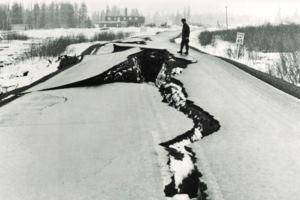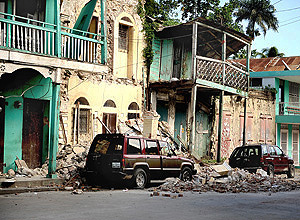This page has been archived and is no longer updated

On January 12, 2010, a 7.0-magnitude earthquake devastated Port-au-Prince, Haiti. Just over a month later on February 27, an even more powerful earthquake — with a magnitude of 8.8 — hit Chile near its second largest city, Concepción. The images of destruction from both of these disasters have been shocking. Buildings were smashed like children's toys. Bridges collapsed, and highway overpasses buckled. In Haiti, an estimated 230,000 to 300,000 people died as a result of the earthquake. In Chile, the death toll was around 700. In both cases, buildings and infrastructure were damaged and there was loss of life — but why were so many more people killed in the Haitian quake? How can similar large losses of life be prevented in future earthquakes?
Answering the first question takes some knowledge about the physics of earthquakes. Earth is made up of layers arranged like an onion. At the center lies a solid iron core. Surrounding the core is a liquid layer of iron, followed by a mantle layer of molten rock. The outer surface of the Earth is a thin crust of fragile rock. Although the crust feels solid to us, it is actually fractured into twelve pieces, called the tectonic plates. These plates float on the mantle layer, and as they do, the boundaries between the plates push against each other. Sometimes the boundaries slide past each other relatively smoothly — but many times they become locked, with the rock on either side of the boundary bending like rubber from the stress of the restricted movement. When the stress becomes too great, the boundaries snap past each other, creating an earthquake in the ground above (the epicenter). The release of stress produces several different kinds of motions in the ground: up-and-down, side-to-side, and rolling motions like waves.
Although the motions of an earthquake are frightening, they alone cause very little loss of life. There is an old engineering adage that states, "Earthquakes don't kill people; buildings do." One of the most critical determining factors in whether an earthquake will result in many fatalities or few is the type of buildings present near the epicenter. For everyday purposes, buildings are made to withstand the force of gravity and the forces of their own structural design. These are unmoving forces. The forces produced by earthquakes, particularly the side-to-side and rolling motions, are completely different. Unless a building is made to be flexible enough to bend with those forces or sturdy enough to withstand them, it will collapse in a strong earthquake, killing or trapping those within. Tragically, this was the case in Haiti, where the nation's impoverished conditions resulted in the construction of brittle, weak structures that could not withstand the ground motions of the earthquake. Chile, a more developed nation, had a higher percentage of stronger and more flexible buildings that were better able to stay up during that quake, sparing the lives within.
Understanding this, we can begin to find answers to the second question of how such a great loss of life can be prevented in future earthquakes. Earthquake engineering, which has arisen over the last hundred years, is a field devoted to mitigating earthquake hazards. Earthquake engineers investigate the reasons why infrastructure and buildings fail during earthquakes and then apply their knowledge to planning, designing, constructing, and managing earthquake-resistant structures and facilities. In this Spotlight, we will take a closer look at why some buildings, roads, bridges, and overpasses fail during strong earthquakes, and then explore how earthquake engineering can be used to build safer structures. We will also look at the investigative science of earthquake prediction in order to understand what can — and cannot — be done to warn people before disaster strikes.
Image: US Army.
Explore how the Earth's crust slips, slides, and dips.
See the science behind measuring an earthquake's magnitude.
The US Geological Survey debunks commons myths about earthquakes.
Learn about the destruction that is caused by earthquakes: seismic vibrations, soil liquefaction, landslides, fire, and tsunamis.
The USGS lists the largest-magnitude earthquakes in the US with links to damage photos, maps, and event summary pages.
Experience what it is like to live through an earthquake in this ABC News anniversary special about the geological event that took place in California's San Francisco Bay Area.
The Science Channel provides an overview of modern earthquake-resistant construction techniques.
Learn about structural problems in single-family homes that can result in heavy damage during an earthquake.
Watch a Wired magazine interview with an earthquake engineer at the Earthquake Engineering Research Center.
Watch a Stanford professor explain a new design that lets buildings fall back into plumb after an earthquake.
See how various types of buildings will fare during an earthquake. [pdf]
Popular Mechanics reports on the building of the new, quake-proof San Francisco-Oakland Bay Bridge.
Can they be predicted? Listen to this USGS podcast that answers the question most on the minds of those following the coverage of earthquake-related devastation.
Can animals sense oncoming earthquakes? This National Geographic article looks at the evidence and the many historical accounts that abound in support of animals' uncanny abilities.
Learn how hazard maps are used to determine the probability of an earthquake in a given location over time. You may be surprised by the places in danger.
